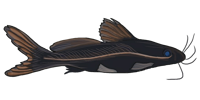L-66
L-66
How long does it take before the eggs hatches? I was about to rearranged my L-66 tank, but to my suprised, theres eggs in there, should I removed them or let the male take care of of them? They look like they're fertile, it's gotta nice greenish color to them..
-
andywoolloo
- Posts: 2751
- Joined: 02 Dec 2007, 02:55
- I've donated: $100.00!
- My cats species list: 12 (i:0, k:0)
- My aquaria list: 1 (i:1)
- Location 2: Sanger, California
Re: L-66
Is there someone else in the tank that might eat them or just your tigers? IMHO I'd leave them in with the parents unless you think a tank mate might eat them. Cover your intake with a breathable sponge. So the fry don't get sucked up!
My tigers have not mated yet, if they are tigers, and if I have a male and a female.
But if they are anything like BN eggs, takes about 5-7 days for the babies to hatch then they have their egg sacs for about a week. then it's ON with feeding and cleaning the tank!
Here is a good article from this site on tigers spawning.
http://www.planetcatfish.com/shanesworl ... cle_id=248
and another hypan
http://www.planetcatfish.com/shanesworl ... icle_id=98
My tigers have not mated yet, if they are tigers, and if I have a male and a female.
But if they are anything like BN eggs, takes about 5-7 days for the babies to hatch then they have their egg sacs for about a week. then it's ON with feeding and cleaning the tank!
Here is a good article from this site on tigers spawning.
http://www.planetcatfish.com/shanesworl ... cle_id=248
and another hypan
http://www.planetcatfish.com/shanesworl ... icle_id=98
- AndrewC
- Posts: 237
- Joined: 16 Jul 2004, 21:50
- My cats species list: 3 (i:0, k:0)
- Spotted: 1
- Location 2: Renfrewshire, Scotland, UK.
Re: L-66
Good going.
Not bred my L66 yet, but bred some other hypancistrus.
It is best to leave the eggs with the male, the male will take care of the eggs much better than the eggs sitting in a fry trap with an airstone airiating them.
The only time i hatch eggs in a fry trap is when i find them lying outside the cave, sometimes a inexperienced male can knock the eggs out by accident.
The fry will take three weeks to fully devolp, and i find most fry leave the cave around three week time, but some may take a little bit longer to leave the cave.
Try leaving the fry in the tank with the parents for the first month or so, before moving them onto a growout tank (if you were planning on using growout tank), fry do better when kept in the parents tank in the beginning.
Not bred my L66 yet, but bred some other hypancistrus.
It is best to leave the eggs with the male, the male will take care of the eggs much better than the eggs sitting in a fry trap with an airstone airiating them.
The only time i hatch eggs in a fry trap is when i find them lying outside the cave, sometimes a inexperienced male can knock the eggs out by accident.
The fry will take three weeks to fully devolp, and i find most fry leave the cave around three week time, but some may take a little bit longer to leave the cave.
Try leaving the fry in the tank with the parents for the first month or so, before moving them onto a growout tank (if you were planning on using growout tank), fry do better when kept in the parents tank in the beginning.
- apistomaster
- Posts: 4735
- Joined: 10 Jun 2006, 14:26
- I've donated: $90.00!
- My articles: 1
- My cats species list: 12 (i:0, k:0)
- My Wishlist: 1
- Location 1: Clarkston, WA, USA
- Location 2: Clarkston, WA, USA
- Interests: Aquaculture and flyfishing
Re: L-66
I use a similar approach as Andrew.
One feature I like to include in a Hypancistrus sp breeding tank is stacks of slate or thin slabs of sawed petrified wood placed in stacks about their tank with >0.5 cm spacers between them to provide the fry with hiding places secure from the access of the adults.
Their fry are so delicate that moving them too soon is likely to cause higher losses than leaving them alone.
I do think it is best for the fry if the breeding tanks do not contain more then 2 m and 4 F. More than that could mean that non-breeding members of the group could harm some fry just in going about their normal routines.
One feature I like to include in a Hypancistrus sp breeding tank is stacks of slate or thin slabs of sawed petrified wood placed in stacks about their tank with >0.5 cm spacers between them to provide the fry with hiding places secure from the access of the adults.
Their fry are so delicate that moving them too soon is likely to cause higher losses than leaving them alone.
I do think it is best for the fry if the breeding tanks do not contain more then 2 m and 4 F. More than that could mean that non-breeding members of the group could harm some fry just in going about their normal routines.
Avid Trout fly fisherman. ·´¯`·...¸><)))º>
Re: L-66
I will go ahead and file up some slates in there with some gaps just enough for the frys to hide.. I checked out the caves earlier and they all seem to be doing well, I've seen them moving now, all the eggs have hatched.. Male is doing a good job for a first timer, unless I missed him spawn before..
- jac
- Posts: 1224
- Joined: 19 Apr 2008, 13:56
- My articles: 3
- My images: 71
- My cats species list: 84 (i:0, k:23)
- My BLogs: 15 (i:16, p:671)
- Spotted: 45
- Location 1: Ede
- Location 2: Holland
- Interests: Fish of all types but mostly Loricariidae, Callichthyidae and Auchenipteridae. My awesome dogs and walking through nature and taking pictures.
Re: L-66
Hi,
I'm very curious how the fry are doing
I now have my first spawn of my L66. And I wondering how you feed the fry There are 11 adults in my tank and they are always very hungry when feeding time. The food is al eaten within a few minutes. How do I know that the fry get there food?
There are 11 adults in my tank and they are always very hungry when feeding time. The food is al eaten within a few minutes. How do I know that the fry get there food?
I've read that it is better to leave the fry in with the parents so I was not thinking of seperating them as the hatch.
Is it maybe better to put cave, dad and the eggs in a seperate tank within the existing tank and filter with sponge filters to keep water circulated? That way the fry stay with dad and I can feed the fry seperatly.
Thanks in advance
I'm very curious how the fry are doing
I now have my first spawn of my L66. And I wondering how you feed the fry
I've read that it is better to leave the fry in with the parents so I was not thinking of seperating them as the hatch.
Is it maybe better to put cave, dad and the eggs in a seperate tank within the existing tank and filter with sponge filters to keep water circulated? That way the fry stay with dad and I can feed the fry seperatly.
Thanks in advance
Every great achievement begins with a dream 
- apistomaster
- Posts: 4735
- Joined: 10 Jun 2006, 14:26
- I've donated: $90.00!
- My articles: 1
- My cats species list: 12 (i:0, k:0)
- My Wishlist: 1
- Location 1: Clarkston, WA, USA
- Location 2: Clarkston, WA, USA
- Interests: Aquaculture and flyfishing
Re: L-66
Hi Jac,
You shouldn't try moving a brooding male. just let them develop, leave the cave and allow them at least a month of running around the breeding tank before you try to move them.
I use a lot of Spirulina and Earth worm Sticks for my Hypancistrus fry.(L260 and L333) I feed them at lights out and allow for what the adults eat plus the fry.
Lately, I have been using ceramic soup bowls as containers for many of the food sticks and scatter some elsewhere. Some species fry soon learn to feed from the bowl but this varies with the species. My L134 collect by the dozens in a feeding bowl at all times of the day.
This method helps me not waste food or over feed the tank.
You shouldn't try moving a brooding male. just let them develop, leave the cave and allow them at least a month of running around the breeding tank before you try to move them.
I use a lot of Spirulina and Earth worm Sticks for my Hypancistrus fry.(L260 and L333) I feed them at lights out and allow for what the adults eat plus the fry.
Lately, I have been using ceramic soup bowls as containers for many of the food sticks and scatter some elsewhere. Some species fry soon learn to feed from the bowl but this varies with the species. My L134 collect by the dozens in a feeding bowl at all times of the day.
This method helps me not waste food or over feed the tank.
Avid Trout fly fisherman. ·´¯`·...¸><)))º>
- jac
- Posts: 1224
- Joined: 19 Apr 2008, 13:56
- My articles: 3
- My images: 71
- My cats species list: 84 (i:0, k:23)
- My BLogs: 15 (i:16, p:671)
- Spotted: 45
- Location 1: Ede
- Location 2: Holland
- Interests: Fish of all types but mostly Loricariidae, Callichthyidae and Auchenipteridae. My awesome dogs and walking through nature and taking pictures.
Re: L-66
That sounds like a great ideaapistomaster wrote:Hi Jac,
You shouldn't try moving a brooding male. just let them develop, leave the cave and allow them at least a month of running around the breeding tank before you try to move them.
I use a lot of Spirulina and Earth worm Sticks for my Hypancistrus fry.(L260 and L333) I feed them at lights out and allow for what the adults eat plus the fry.
Lately, I have been using ceramic soup bowls as containers for many of the food sticks and scatter some elsewhere. Some species fry soon learn to feed from the bowl but this varies with the species. My L134 collect by the dozens in a feeding bowl at all times of the day.
This method helps me not waste food or over feed the tank.
I'ts hard trying not to interfere (?) with nature
Every great achievement begins with a dream 




